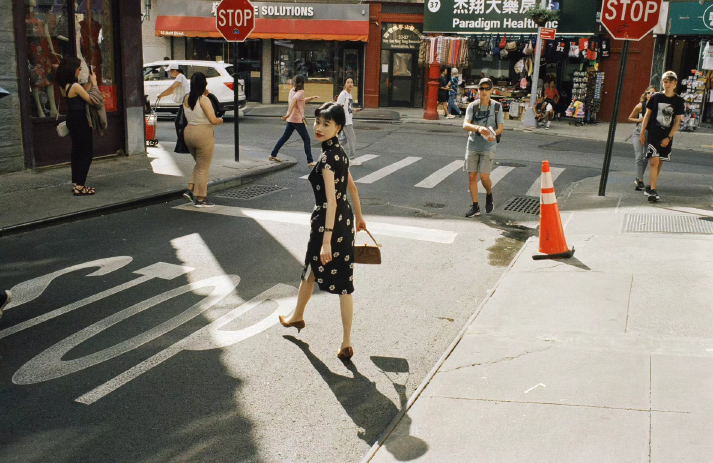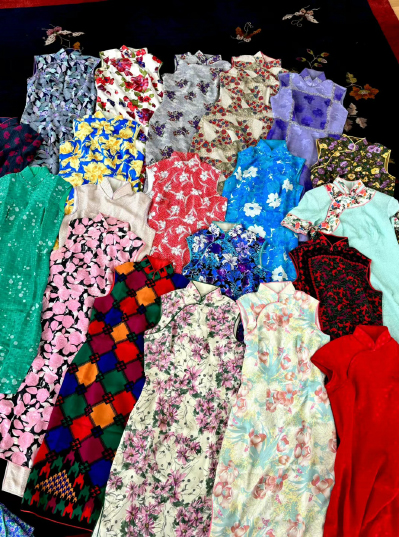| Lifestyle |
| Vintage in vogue | |
|
|
 A selection of vintage qipao dresses Heather Guo has purchased in the U.S. this year, which were customized in Hong Kong in the 1950s and 60s (COURTESY PHOTO)
In the bustling neighborhood of Manhattan, nestled inside a building dating back to the 1920s, Heather Guo's store bears a different tone, allowing visitors to revel in a world of vintage gems. Among her eclectic collections of antique carpets, old Hong Kong movie posters and vintage lamps, the racks packed with brightly colored traditional Chinese qipao immediately catch the eye. In standard Chinese, the modern term qipao refers to a one-piece Chinese dress that has its origins in the 1920s. The 23-year-old entrepreneur and the creative mind behind the store opened Hoeng Gong Silk Co. in the fashionable metropolis of New York City in 2023. Guo went to the U.S. at the age of 14 to attend high school and later majored in classics and art history at New York University. With a particular interest in antiques, she's been tracking down and acquiring vintage qipao from dealers, immigrants and collectors in the North American market since she was in college. In February 2023, Guo stumbled upon a large collection of vintage qipao made in Hong Kong during the 1960s at a gift shop in New York City's Chinatown. According to Guo, these dresses, tucked away for nearly six decades, had been well-preserved due to the dry environment of their storage location. "That discovery prompted me to open a vintage qipao shop later that very month, with the hope of finding new owners who would give these dresses a second life," Guo told Beijing Review. Her college foray into acquiring and selling antiques had generated the funds to set up shop. Located in Manhattan's West Village, the boutique specializes in offering both ready-to-wear and customized qipao in the distinctive Hong Kong style. The brand name "Heong Gong" derives from the Cantonese pronunciation of a nickname for Hong Kong. Creative and cosmopolitan The qipao traces its origins back to the traditional attire of the Manchu ethnic group, who ruled China during the Qing Dynasty (1644-1911). Evolving in design over time, the qipao gained popularity in the 1920s and 30s among women of high social standing and students in Shanghai, then a burgeoning cosmopolitan hub. Characterized by its form-fitting silhouette, high collar and side slits that accentuate the female figure, the qipao became an emblem of self-expression for confident women. During the 1950s and 60s, Hong Kong emerged as an international megalopolis and a hub of Chinese fashion. Hong Kong-style qipao made during this era became ubiquitous in Hong Kong cinema, symbolizing elegance, style and modernity. Influenced by emerging fashion trends from the Western world, the qipao produced in Hong Kong during that time blended Western and Chinese design elements, embracing a more feminine silhouette with defined waistlines and accentuated hourglass figures, Guo noted. The length of the Hong Kong-style qipao typically falls at the knees, making it practical for everyday wear while retaining the elegance and sophistication of a traditional dress design. The iconic garment transcended borders, spreading to overseas Chinese communities through Hong Kong, where many pieces have endured the test of time, now treasured as vintage fashion pieces.  Vintage qipao dresses Heather Guo has purchased in the U.S. this year, which were customized in Hong Kong in the 1950s-1960s for an immigrant (COURTESY PHOTO)
Better with age When she first came across the hundreds of qipao at that serendipitous New York gift shop, Guo was astonished by the garments' beauty, especially the old Hong Kong silk they were crafted from. The gift shop owner, who had transported the dresses across the Pacific Ocean, had been unsuccessful in selling them and therefore stored them away. Many of the boxes containing these antique garments had remained sealed and untouched until Guo's discovery. "These dresses were created during Hong Kong's golden era of fashion. They were densely woven, often featuring intricate patterns. I acquired the entire collection from the shop owner," Guo explained. To manage her extensive inventory, Guo decided to match each dress with its most suitable owner. Many of the vintage garments were originally handmade to fit the body shape and personal preferences of their previous owners, mostly featuring flower and bird patterns and delicately designed details. The average price of a vintage qipao in Guo's store hovers around $300, with prices varying depending on the fabrics used and the original purchase prices. Common fabrics include silk, brocade, velvet and cotton. Guo's customers are mostly Chinese women who study, work and live in the U.S. Guo has helped over 500 dresses find new owners since her store opened. Additionally, the boutique sees a consistent influx of customers with appointments to visit and try on the dresses. For many customers, a vintage qipao represents more than just style; it embodies tales from the past. Finding a piece that fits perfectly is considered a stroke of luck and adds to the allure of the experience. A new look The website of Hoeng Gong Silk Co. showcases the new-pattern qipao introduced earlier this year, reflecting Guo's contemporary fashion sense. "As time goes by, it's becoming more and more difficult for us to find vintage qipao. We decided to open up a workshop in China dedicated to creating qipao inspired by the silhouettes of the 1950s and 60s," she said. While upholding tradition, Guo integrates modern fashion concepts into the designs by making adjustments for comfort, such as lowering the collars, and expanding the range of patterns and color options. Her store's tailors employ traditional techniques and offer customers the chance to personalize their dresses. Since 2023, Guo has made several trips to Hangzhou, east China's Zhejiang Province, known as a hub for Chinese silk production and distribution, to source fabrics. "The silk market there offers a diverse selection of high-quality silk fabrics for us to choose from. I believe that the patterns created by Chinese designers naturally lend themselves well to qipao designs," she added. Guo has established a workshop in China staffed by four tailors who produce around 150 dresses per month. "Since many of our customers visit the New York store every month, we have collected a large amount of data to set the six sizes for ready-to-wear qipao, to make it possible for most people to instantly find a dress that fits," Guo said. Of course, the store also gives them the option to have the garment altered. One of Guo's clients, known as "Eden" on Xiaohongshu, a wildly popular Chinese lifestyle and e-commerce app, is currently studying in the U.S. Eden once thought that the qipao was a thing of the past and made people look older than they are. "But after trying one on at Guo's store, my perspective shifted. I like her innovation, especially the size-inclusive designs that are available there," she wrote on her Xiaohongshu account. The traditional qipao design has undergone continuous evolution throughout the years, showcasing distinct styles in various regions across China. In recent years, the emergence of xinzhongshi, or "new Chinese style," which incorporates a fusion of traditional and contemporary elements, has gained popularity. The qipao as well as xinzhongshi garments with similar collar and button designs inspired by the traditional dress are increasingly embraced by younger Chinese generations as a fashionable choice for everyday wear. Guo herself wears qipao every day. "The qipao is a perfect everyday dress as it is not difficult to put on, and it allows the wearer to move around comfortably. I hope more people will wear it as an everyday outfit given it mixes and matches very well with urban life," she said. "The qipao for me is also a symbol of Chinese culture and heritage, and a reminder of my connection to China. By wearing the qipao, we celebrate our Chinese identity," Guo added. Copyedited by Elsbeth van Paridon Comments to lixiaoyang@cicgamericas.com |
|
||||||||||||||||||||||||||||
|